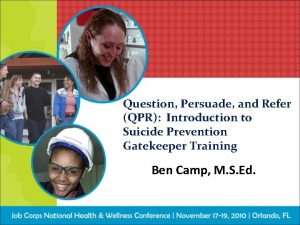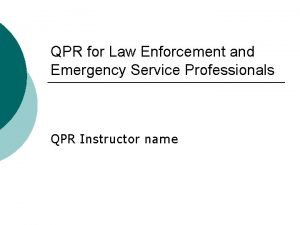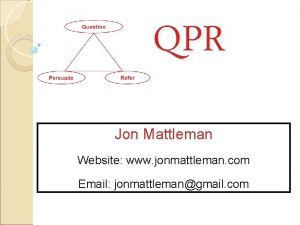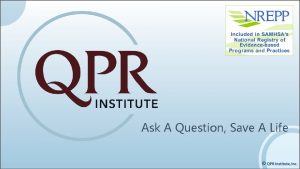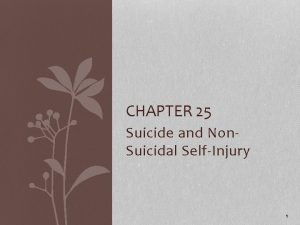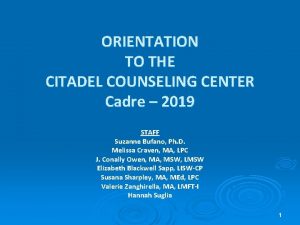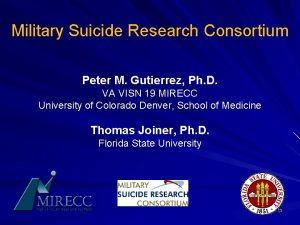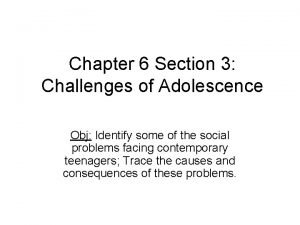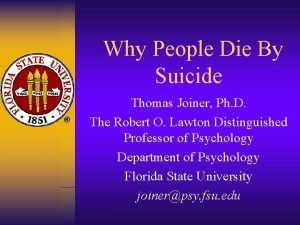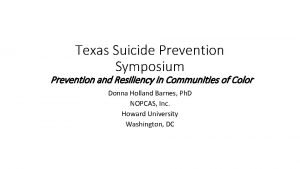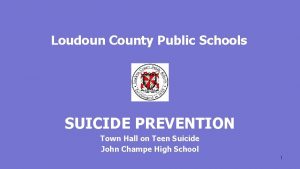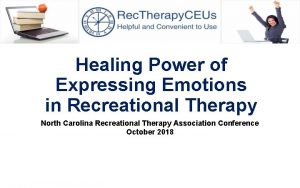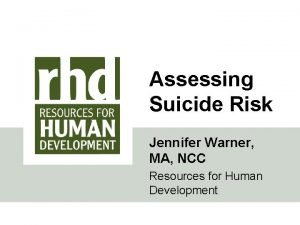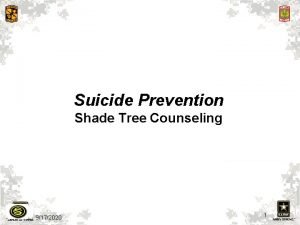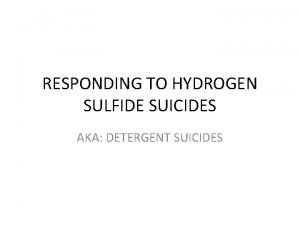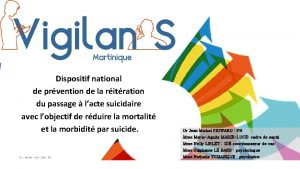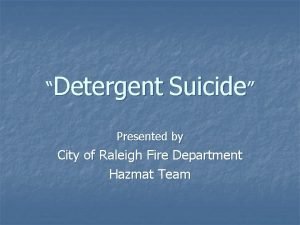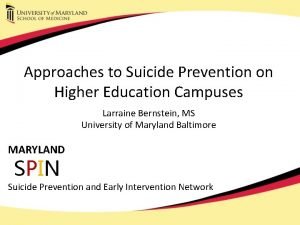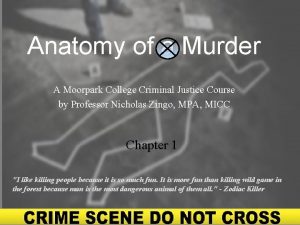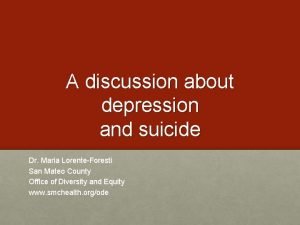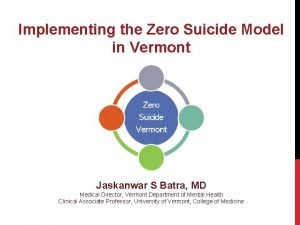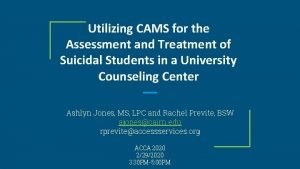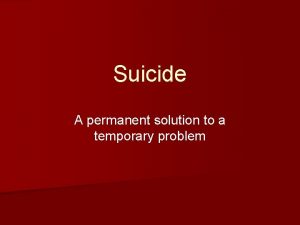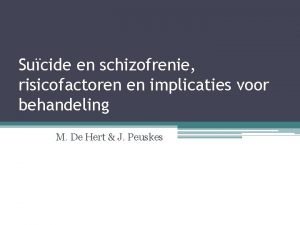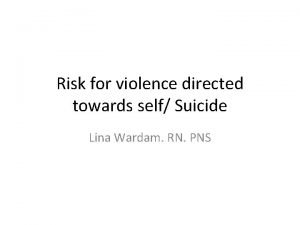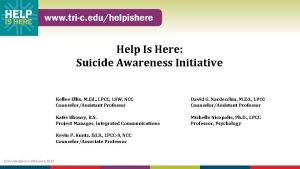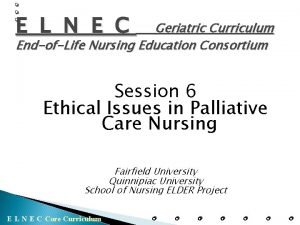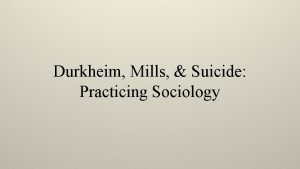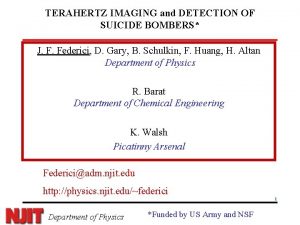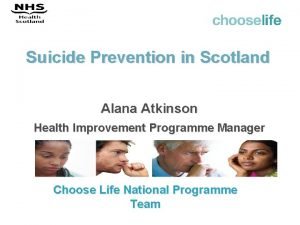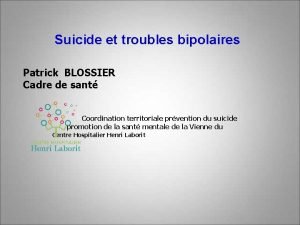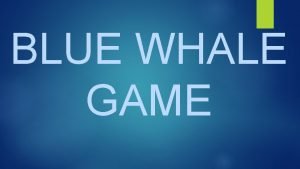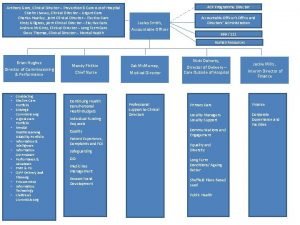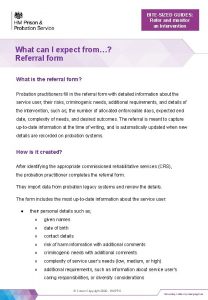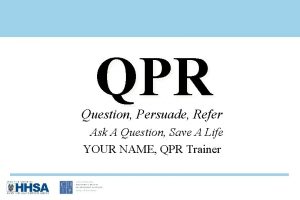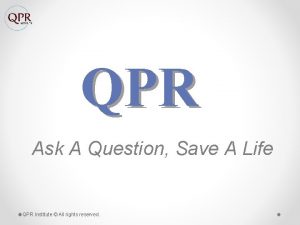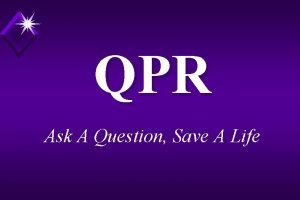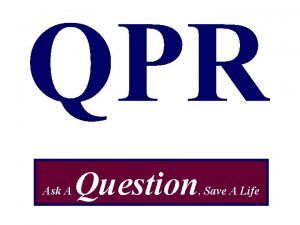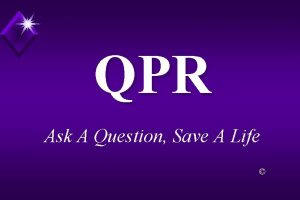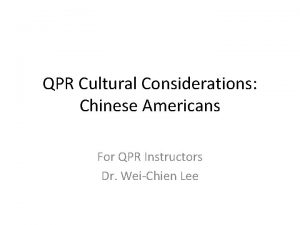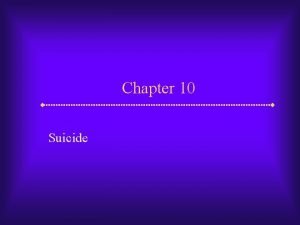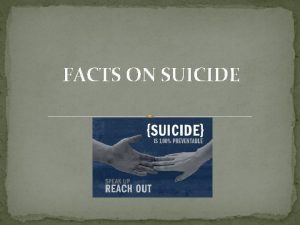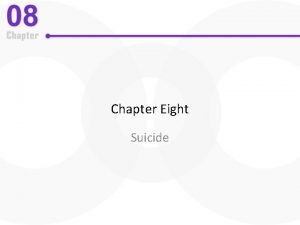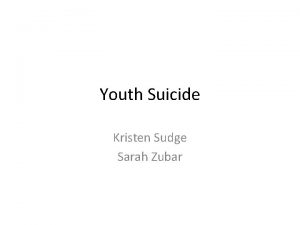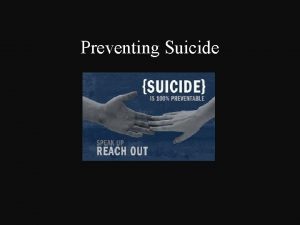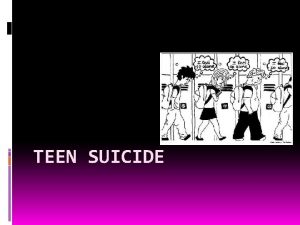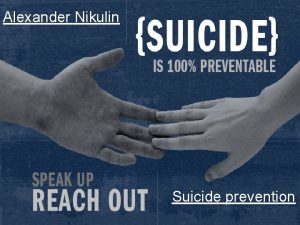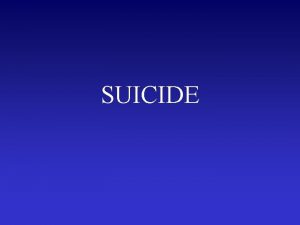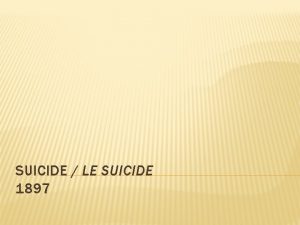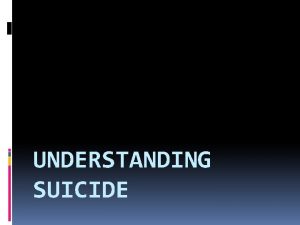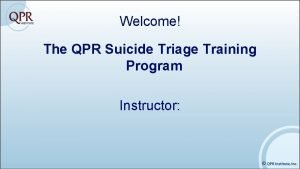Question Persuade and Refer QPR Introduction to Suicide









































































- Slides: 73

Question, Persuade, and Refer (QPR): Introduction to Suicide Prevention Gatekeeper Training Ben Camp, M. S. Ed. QPR Master Trainer

Before We Get Started I want you to check out the three people sitting nearest to you. �How are they doing? �Do they look OK? �How do they appear? 2

Ben Camp, M. S. Ed. �Faculty—Washington Institute for Mental Illness Research and Training �Over 30 years experience in COD, Inpt, OP, Adult/Adol, CD/MH at all levels �Former Mental Health Commitment Specialist �Former Director of Training: Suicide Helpline �Community Intervention Specialist: Native Aspirations � Principal author To Live To See The Great Day That Dawns: Preventing Suicide by American Indian and Alaska Native Youth and Young Adults �Faculty Eastern Washington University �National Steering Committee SPRC 3

Learning Objectives By the end of this training and small group discussions, you will be able to: Discuss and articulate suicide as a national and Job Corps public health problem List at least three reasons why people complete suicide Describe theory and rational behind effective gatekeeper training Identify the gatekeeper’s role in the chain of survival Practice at least two QPR skills 4

Suicide is Personal 5

Raise Your Hand If… (Wait until all questions asked) You have ever thought about suicide? You know someone who has? You know anyone who has made a suicide attempt… …or died by suicide? You’re worried, right now, that someone you know is thinking about suicide? 6

Big Picture Think, plan, attempt, die 10 million adults think about suicide each year 1. 2 million plan a method (gun, MVA, etc. ) 840, 000 attempt (minimum count) Approximately 33, 000 die Suicide is 11 th cause of death overall 3 rd for young people (rate has almost tripled since 1950 s) unexpected upturn 2003 -2004 1 st for young people in some states/communities 7

Scope of the Problem � 14% of American youths 12 -17 (3. 5 million youth) experienced at least one episode of major depressive disorder (SAMSHA, 2004) �Over 7% (est. 1. 8 million youths) thought about killing themselves at the time of their worst or most recent episode of MDD �Est. 712, 000 youths tried to kill themselves during their worst or most recent major depressive episode (2. 9% of all youth) 8

Scope of the Problem 15 -24 year olds 1 st, 2 nd, 3 rd cause of death (Utah, ID, College, the nation) 20% of teens seriously considers suicide each year (Grunbaum, 2002); 10% of college population (CHS) 9

A Few More Numbers Boys die 4 X as often as girls Girls attempt more than boys (3 X) Youth: 100 -200 attempts per 1 completion Boys use firearms more, girls OD more Lethality of method contributes to outcomes 90% of youth who die by suicide are suffering from an Axis I mental disorder (mood disorder, substance abuse and often both) 10

Youth Especially at Risk? Highest suicide rate in US? Native American males Greatest increasing rate? African American males (up 200%) Highest rate of suicide attempts? Hispanic youth (males & females) Highest rate of suicide attempts of any group? Hispanic females 11

All the Numbers…(CDC) Think, plan, attempt, die (last 12 months) 19% of all high school students (1 in 5) thought seriously about suicide 14% made suicide plan 8. 3% made an attempt 2, 000 +/- die each year 12

For Your Job Corps Center Of 1, 000 students this year – - 200 will think seriously about suicide - 140 will plan how to kill themselves - 80 will make a suicide attempt Let’s work to make sure none die! 13

Introduction to QPR Gatekeeper Training QPR stands for Question, Persuade and Refer, an emergency mental health intervention that teaches lay and professional Gatekeepers to recognize and respond positively to someone exhibiting suicide warning signs and behaviors. 14

Why QPR? Each letter in QPR represents an idea and an action step QPR intentionally rhymes with CPR – another universal emergency intervention QPR is easy to remember Asking Questions, Persuading people to act and making a Referral are established adult skills “Out of clutter, find simplicity” -Albert Einstein 15

QPR Ask a Question, Save a Life © 16

QPR Question, Persuade, Refer © 17

QPR is not about learning to be a counselor QPR is about offering hope by getting involved and doing something © 18

Suicide Myths and Facts Myth Fact No one can stop a suicide, it is inevitable. If people in a crisis get the help they need, they will probably never be suicidal again. Myth Confronting a person about suicide will only make them angry and increase the risk of suicide. Fact Asking someone directly about suicidal intent lowers anxiety, opens up communication and lowers the risk of an impulsive act. Myth Only experts can prevent suicide. Fact Suicide prevention is everybody’s business, and anyone can help prevent the tragedy of suicide. © 19

Suicide Myths and Facts Myth Fact Suicidal people keep their plans to themselves. Most suicidal people communicate their intent sometime during the week preceding their attempt. Myth Those who talk about suicide don’t do it. Fact People who talk about suicide may try, or even complete, an act of self-destruction. Myth Once a person decides to complete suicide, there is nothing anyone can do to stop them. Fact Suicide is the most preventable kind of death, and almost any positive action may save a life. © 20

Suicide and Homicide More homicides or suicides per year? Is there any overlap between homicide and suicide? Discussion 21

Suicidal Behavior Means someone is in extreme pain and suffering Means complex feelings and behavior Involves many reasons and factors Means approaching from many directions 22

Nature of Suicide and Joiner’s New Theory �Psychic suffering (Psyche-ache) �Hopelessness �Unbearable mental anguish �Cognitive constriction �Grossly impaired problem solving ability �Feeling a burden to others �Thwarted belongingness �Acquired capacity for self-injury and habituation to pain (T. Joiner, Why People Die by Suicide, 2006) 23

Those Who Desire Suicide Those Who Are Capable of Suicide Serious Attempt or Death by Suicide

Journey to Suicide Acquired Capacity for Self-Injury Lethality of method and seriousness of intent increase with attempts People who have experienced or witnessed violence or injury have higher rates of suicide – prostitutes, self-injecting drug abusers, people living in high-crime areas, veterans, physicians Those with a history of suicide attempt have higher pain tolerance than others 25

Those Who Desire Suicide Perceived Burdensomeness Those Who Are Capable of Suicide Thwarted Belongingness Serious Attempt or Death by Suicide

Perceived Burdensomeness Feeling ineffective to the degree that others are burdened is among the strongest sources of all for the desire for suicide. 27

Why do some people want to die? • Feel that I am a burden to my family • Feel that everyone will be better off without me Darkness Calls: The Healthy Aboriginal Network 28

Thwarted Belongingness Our need to belong to valued groups and relationships is so powerful that, if frustrated or thwarted, serious negative health consequences follow – including suicide. 29

Why do some people want to die? Feel like I don’t belong Feel like no one cares if I live or die Darkness Calls: The Healthy Aboriginal Network 30

Those Who Desire Suicide Perceived Burdensomeness Those Who Are Capable of Suicide Thwarted Belongingness Serious Attempt or Death by Suicide

Discussion Take a few minutes to discuss this theory Does it have face validity? Does it seem to be inclusive? What are some ramifications? If this theory is valid, what impact would this have to self referrals? 32

Our Challenge Most youth don’t get treatment because they don’t self-refer or don’t even know they’re depressed So, how do we find and help them before they make a suicide attempt? 33

QPR Suicide Clues And Warning Signs The more clues and signs you notice, the greater the risk. Take all signs seriously. © 34

QPR Direct Verbal Clues: “I’ve decided to kill myself. ” “I wish I were dead. ” “I’m going to commit suicide. ” “I’m going to end it all. ” “If (such and such) doesn’t happen, I’ll kill myself. ” © 35

QPR Indirect Verbal Clues: “I’m tired of life, I just can’t go on. ” “My family would be better off without me. ” “Who cares if I’m dead anyway. ” “I just want out. ” “I won’t be around much longer. ” “Pretty soon you won’t have to worry about me. ” “I’m going to stay with my Grandfather” Who is dead. © 36

Indirect Verbal Clues Darkness Calls: The Healthy Aboriginal Network 37

QPR Behavioral clues: Has made a suicide attempt in the past Acquiring a gun or stockpiling pills Is also depressed, moody, feels hopeless Putting personal affairs in order Giving away prized possessions Sudden interest or disinterest in religion or spirituality Drug or alcohol abuse, or relapse after a period of recovery Unexplained anger, aggression and irritability © 38

Non-Verbal Clues Darkness Calls: The Healthy Aboriginal Network 39

QPR Situational clues: Being fired or being expelled from school Loss of girl/boyfriend or other important relationship Death of a best friend, aunt/uncle, especially if by suicide Being told you have a serious or terminal illness Sudden unexpected loss of freedom/fear of punishment Loss of a favorite counselor, teacher, coach, or supportive person Fear of becoming a burden to others © 40

Suicide Threats Suicide threats are warning signs, but not all suicide warning signs are threats A suicide threat means (at the least) that the person has considered violence but has, for now, decided not to act Only the living make threats 41

Which of the Following is a Suicide Warning Sign? “I’m going to blow my brains out. ” “I just can’t stand it anymore. ” If either is a suicide warning sign, which statement requires immediate and urgent intervention? 42

Content vs. Context �“I’m going to blow my brains out!” Is sitting in your office in a psychiatric hospital �“I just can’t stand it anymore. ” Is standing well out of arm’s reach on the edge of 10 -story building Now… which person needed immediate and aggressive intervention? 43

44

Asking the suicide question 45

Scenario #1 18 Y. O. male showing signs of being disengaged, angry with low to no motivation. When questioned, states that he is just home sick and will be better soon. He stated to his roommate that he “just wanted everybody to leave him alone to do what he needs to do. ” When questioned, he denies suicide. His mother has been calling for the past few days leaving messages with staff that she is greatly concerned. Discussion 46

Why was mother concerned? This 18 Y. O. told his sister a few days ago that wanted to end it all and kill himself. 47

Scenario #2 17 Y. O. female came in late to class and has been missing several of her assignments. The teacher asked her to stay after class where she found out that she has been depressed lately and lacks motivation for school. She is having trouble with some other girls on center and feels like she doesn’t belong. She ends the meeting by stating “I have learned my lesson. ” She wants to do better in class and is asking how she can make up her assignments. Discussion 48

Why was she late for class? This student took an overdose of 20 aspirin tablets and 4 sleeping pills she brought from home. After waking up she decided to come to class without telling anyone what she had done. 49

Last Words from Real Cases Depressed farmer to inpatient nurse on discharge, “Don’t worry about me, I’ll be six feet under by Friday. ” Depressed boy to mother, “Do you think God has a place in heaven for a boy like me? ” Father to son, “I’m going home soon. ” WWII vet to social worker, “Don’t worry, when the going gets tough the tough know what to do. ” 50

Examples from Real Cases Parishioner to Pastor, “Do people who kill themselves go to hell? ” Catholic woman to best friend, “It’ll be fine, I’ve seen the virgin. ” Patient to pharmacist, “Are you sure this is enough medicine to cause death? ” Patient to doctor, “You’ve been a wonderful doctor. Thanks for everything. ” 51

The 7 D’s of Suicide Risk Assessment Did you? Develop an empathetic and respectful relationship? Define the problem(s) suicide would solve? Detect suicide ideation? Determine desire, capability, intent, and means availability? Detail risk and protective factors? Decide on level of acute risk present? Develop a collaborative crisis mitigation, means restriction and follow up plan? 52

SRMI quiz (1, 100+ practicing professionals) 53

Suicidal Communications Clump Up If you were suicidal, who would you tell? How would you tell them? How many times would you tell them? What would you do if people did not respond? How would you change your message if ignored? 54

QPR Theory Assumption: passive systems don’t work Those most at risk for suicide: tend not to self-refer for treatment tend to be treatment resistant often abuse drugs and/or alcohol dissimulate their level of despair go undetected go untreated (and remain at risk for suicide) 55

QPR Theory Most suicidal people send warning signs Warning signs can be taught Gatekeepers can be trained to a) recognize suicide warning signs and, b) intervene with someone they know Gatekeepers must be fully supported by policy, procedure and professionals in their community 56

Goals for QPR Gatekeeper Training Effective Gatekeepers: Are alert to the possibility of suicide Know suicide risk factors Recognize symptoms of distress and depression Recognize suicide warning signs Know what to say, when to say it, and what to do 57

The QPR Chain of Survival 4 links… 1. Early recognition of warning signs 2. Early application of QPR 3. Early referral to professional care 4. Early assessment and treatment Knowledge + Practice = Action 58

Seven Life-Saving Goals Detection of suicidal persons Active intervention Alleviation of immediate risk factors Accompanied referral Access to treatment Accurate diagnosis Aggressive treatment “Ask the question, save a life. ” 59

QPR Prevention Strategy AWARENESS Suicidal Thoughts Perceived Insoluble Problem SURVEILLANCE Suicidal Warning Signs DETECTION Suicide Attempt INTERVENTION Suicide injury or death OPPORTUNITIES Question Persuade Refer Treat 60

A Simple Truth The person most likely to prevent you from taking your own life is someone you already know 61

Untrained Detection Network Teacher Best friend s Co de ue Cl d d Cl de ue s Co Student in crisis No Clues Coded Clues Parents ue s Job Corps Site counselor Diagram 1 es Cl d de lu C Co o Job Corps Site nurse N • Intervention unlikely Clear Verbal Threats • Hotline call unlikely & Uncoded Clues • Self-referral unlikely n Pastor io tat ul s on C Girlfriend Source: Paul Quinnett, Ph. D. , QPR for Suicide Prevention 62

QPR Gatekeeper Network Teachers Counselor Network Trained to detect suicidal students Food service staff Best friend Teacher applies QPR Intervention l a rr fe Re l a err f e R Student gets support Nurse Parents Depression/ alcohol Girlfriend screening • Question Asked • Persuaded • Referral Completed Source: Paul Quinnett, Ph. D. , QPR for Suicide Prevention Diagram 2 Suicide attempt averted 63

Research Questions Does QPR Training Produce…. Changes in knowledge, attitude, perceived self- efficacy among adults? Yes. Changes in detection rates? Yes. Increases in referrals? Yes. Changes in service utilization (crisis response and outside providers)? Yes. 64

If Overwhelmed by Life…. Georgia high school students with suicide attempts were 2 to 3 times less likely to endorse help-seeking when in crisis Conclusion: those students at highest risk, and the most hopeless, are the least likely to ask for help! Solution? WE MUST GO TO THEM! 65

Complete Research Go to http: //www. qprinstitute. com/ Click Evidence of QPR on left hand side of page 66

We Feel that Suicide Prevention Training Should… Match level of training with level of duty Be delivered in a standardized fashion Provide measurable outcomes Embrace technology Be culture-sensitive and acceptable to learners Be low-cost, compared to other options 67

Advanced Online Training � Training from EWU for Job Corps Center Counselors, Psychologists, Nurses and Social Workers � Suicide risk detection, assessment and management training � University based - CEU or college credit � APA approved (6 hours) � Blended DVD, study guide, + online � Certificate 68

Take Out Your Booklets On the back side is a website, user ID, and password http: //www. qprtraining. com 69

Change Organization for Alternative 70

Resources Free book for download Suicide: The Forever Decision qprinstitute. com 71

Resources 72

Contact Information �Paul Quinnett: 509 -235 -8823 �www. qprinstitute. com �Ben Camp: 509 -939 -7001 �Bcampsight@aol. com Please visit our web site and download the free e-book: Suicide: the Forever Decision and share it widely…. . 73
 Costas level of questions
Costas level of questions Hinge theorem
Hinge theorem Qpr test answers
Qpr test answers Qpr gatekeeper quiz answers
Qpr gatekeeper quiz answers Qpr
Qpr Qpr enterprise architect
Qpr enterprise architect Qpr logo
Qpr logo Qpr enterprise architect
Qpr enterprise architect Qpr training quiz answers
Qpr training quiz answers The sad persons scale
The sad persons scale Moderately open question
Moderately open question Suicide girls colombia
Suicide girls colombia Mad acronym suicide prevention
Mad acronym suicide prevention Citadel cadet suicide
Citadel cadet suicide Youth suicide research consortium
Youth suicide research consortium Rvguev
Rvguev Icd 10 intoksikasi makanan
Icd 10 intoksikasi makanan Glencoe health chapter 5 mental and emotional problems
Glencoe health chapter 5 mental and emotional problems Egoistic suicide
Egoistic suicide Suicide cuts across all social categories
Suicide cuts across all social categories Why people die by suicide joiner
Why people die by suicide joiner Suicide chain teach
Suicide chain teach Texas suicide prevention symposium
Texas suicide prevention symposium Suicide prevention sink
Suicide prevention sink Loudoun county suicide
Loudoun county suicide Break up suicide
Break up suicide Synthase vs synthetase
Synthase vs synthetase Enzymes examples
Enzymes examples Dr. spock's son committed suicide
Dr. spock's son committed suicide Slap suicide assessment
Slap suicide assessment Shadetree army
Shadetree army Detergent suicide
Detergent suicide Mathieu sohier
Mathieu sohier Prévention du suicide
Prévention du suicide Detergent suicide
Detergent suicide Dr guy lustig - centre médico-esthétique séléstat
Dr guy lustig - centre médico-esthétique séléstat Livi jay suicide
Livi jay suicide Moorpark college criminal justice
Moorpark college criminal justice Dr maria suicide
Dr maria suicide Desitter suicide
Desitter suicide Suscinio suicide
Suscinio suicide Suicide prevention month quotes
Suicide prevention month quotes Dr jaskanwar batra
Dr jaskanwar batra St josephs suicide
St josephs suicide 1941-1882
1941-1882 Cams suicide assessment
Cams suicide assessment Army suicide prevention training
Army suicide prevention training Suicide is a permanent solution to a temporary problem
Suicide is a permanent solution to a temporary problem Risicofactoren suicide
Risicofactoren suicide Risicofactoren suicide
Risicofactoren suicide Sad person score
Sad person score Dawn marie wesley
Dawn marie wesley Thomas joiner suicide
Thomas joiner suicide 988 suicide
988 suicide Hitler suicide
Hitler suicide Ethical issues in nursing education
Ethical issues in nursing education Types of suicide
Types of suicide Dead sociologists
Dead sociologists Njit suicide
Njit suicide Alana atkinson
Alana atkinson Vivien blossier
Vivien blossier Ralph waldo emerson famous quotes
Ralph waldo emerson famous quotes Why assisted suicide is bad
Why assisted suicide is bad Geeky medics verify death
Geeky medics verify death Philipp budeikin
Philipp budeikin Kirsty gillgrass
Kirsty gillgrass Refer and monitor
Refer and monitor Which of the following is a name term sign symbol design
Which of the following is a name term sign symbol design Question without question words
Question without question words Remarks adalah
Remarks adalah Factor
Factor Direct vs indirect questions examples
Direct vs indirect questions examples Examples of compelling and supporting questions
Examples of compelling and supporting questions What is a compelling question
What is a compelling question



